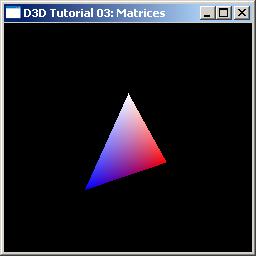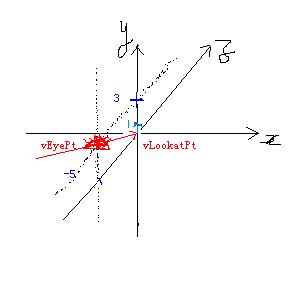術(shù)語(yǔ):
rotation period 旋轉(zhuǎn)周期
radians 弧度

//-----------------------------------------------------------------------------
// File: Matrices.cpp
//
// Desc: Now that we know how to create a device and render some 2D vertices,
// this tutorial goes the next step and renders 3D geometry. To deal with
// 3D geometry we need to introduce the use of 4x4 matrices to transform
// the geometry with translations, rotations, scaling, and setting up our
// camera.
//
// Geometry is defined in model space. We can move it (translation),
// rotate it (rotation), or stretch it (scaling) using a world transform.
// The geometry is then said to be in world space. Next, we need to
// position the camera, or eye point, somewhere to look at the geometry.
// Another transform, via the view matrix, is used, to position and
// rotate our view. With the geometry then in view space, our last
// transform is the projection transform, which "projects" the 3D scene
// into our 2D viewport.
//
// Note that in this tutorial, we are introducing the use of D3DX, which
// is a set of helper utilities for D3D. In this case, we are using some
// of D3DX's useful matrix initialization functions. To use D3DX, simply
// include <d3dx9.h> and link with d3dx9.lib.
//
// Copyright (c) Microsoft Corporation. All rights reserved.
//-----------------------------------------------------------------------------
#include <Windows.h>
#include <mmsystem.h>
#include <d3dx9.h>
#pragma warning( disable : 4996 ) // disable deprecated warning
#include <strsafe.h>
#pragma warning( default : 4996 )
//-----------------------------------------------------------------------------
// Global variables
//-----------------------------------------------------------------------------
LPDIRECT3D9 g_pD3D = NULL; // Used to create the D3DDevice
LPDIRECT3DDEVICE9 g_pd3dDevice = NULL; // Our rendering device
LPDIRECT3DVERTEXBUFFER9 g_pVB = NULL; // Buffer to hold vertices
// A structure for our custom vertex type
struct CUSTOMVERTEX
{
FLOAT x, y, z; // The untransformed, 3D position for the vertex
DWORD color; // The vertex color
};
// Our custom FVF, which describes our custom vertex structure
#define D3DFVF_CUSTOMVERTEX (D3DFVF_XYZ|D3DFVF_DIFFUSE)
//-----------------------------------------------------------------------------
// Name: InitD3D()
// Desc: Initializes Direct3D
//-----------------------------------------------------------------------------
HRESULT InitD3D( HWND hWnd )
{
// Create the D3D object.
if( NULL == ( g_pD3D = Direct3DCreate9( D3D_SDK_VERSION ) ) )
return E_FAIL;
// Set up the structure used to create the D3DDevice
D3DPRESENT_PARAMETERS d3dpp;
ZeroMemory( &d3dpp, sizeof(d3dpp) );
d3dpp.Windowed = TRUE;
d3dpp.SwapEffect = D3DSWAPEFFECT_DISCARD;
d3dpp.BackBufferFormat = D3DFMT_UNKNOWN;
// Create the D3DDevice
if( FAILED( g_pD3D->CreateDevice( D3DADAPTER_DEFAULT, D3DDEVTYPE_HAL, hWnd,
D3DCREATE_SOFTWARE_VERTEXPROCESSING,
&d3dpp, &g_pd3dDevice ) ) )
{
return E_FAIL;
}
// Turn off culling, so we see the front and back of the triangle
// 關(guān)閉剔除,以便三角形的前后都能被我們看到
g_pd3dDevice->SetRenderState( D3DRS_CULLMODE, D3DCULL_NONE );
// Turn off D3D lighting, since we are providing our own vertex colors
// 關(guān)閉D3D光照,因?yàn)槲覀兲峁┪覀冏约旱捻旤c(diǎn)顏色
g_pd3dDevice->SetRenderState( D3DRS_LIGHTING, FALSE );
return S_OK;
}
//-----------------------------------------------------------------------------
// Name: InitGeometry()
// Desc: Creates the scene geometry
//-----------------------------------------------------------------------------
HRESULT InitGeometry()
{
// Initialize three vertices for rendering a triangle
CUSTOMVERTEX g_Vertices[] =
{
{ -1.0f,-1.0f, 0.0f, 0xffff0000, },
{ 1.0f,-1.0f, 0.0f, 0xff0000ff, },
{ 0.0f, 1.0f, 0.0f, 0xffffffff, },
};
// Create the vertex buffer.
if( FAILED( g_pd3dDevice->CreateVertexBuffer( 3*sizeof(CUSTOMVERTEX),
0, D3DFVF_CUSTOMVERTEX,
D3DPOOL_DEFAULT, &g_pVB, NULL ) ) )
{
return E_FAIL;
}
// Fill the vertex buffer.
VOID* pVertices;
if( FAILED( g_pVB->Lock( 0, sizeof(g_Vertices), (void**)&pVertices, 0 ) ) )
return E_FAIL;
memcpy( pVertices, g_Vertices, sizeof(g_Vertices) );
g_pVB->Unlock();
return S_OK;
}
//-----------------------------------------------------------------------------
// Name: Cleanup()
// Desc: Releases all previously initialized objects
//-----------------------------------------------------------------------------
VOID Cleanup()
{
if( g_pVB != NULL )
g_pVB->Release();
if( g_pd3dDevice != NULL )
g_pd3dDevice->Release();
if( g_pD3D != NULL )
g_pD3D->Release();
}
下面是最關(guān)鍵的函數(shù):
//-----------------------------------------------------------------------------
// Name: SetupMatrices()
// Desc: Sets up the world, view, and projection transform matrices.
//-----------------------------------------------------------------------------
VOID SetupMatrices()
{
// For our world matrix, we will just rotate the object about the y-axis.
// 物件只圍繞y軸旋轉(zhuǎn)
D3DXMATRIXA16 matWorld;
// Set up the rotation matrix to generate 1 full rotation (2*PI radians) every 1000 ms.
// 配置旋轉(zhuǎn)矩陣為每1000ms一整圈(2*PI 弧度)
// To avoid the loss of precision inherent in very high floating point numbers,
// 為了避免高浮點(diǎn)數(shù)固有的精度損失,
// the system time is modulated by the rotation period before conversion to a radian angle.
// 系統(tǒng)時(shí)間被旋轉(zhuǎn)周期求模,在它被轉(zhuǎn)化成弧度角前
UINT iTime = timeGetTime() % 1000;
FLOAT fAngle = iTime * (2.0f * D3DX_PI) / 1000.0f;
D3DXMatrixRotationY( &matWorld, fAngle );
g_pd3dDevice->SetTransform( D3DTS_WORLD, &matWorld );
設(shè)置視圖矩陣,看圖:

// Set up our view matrix.
// 設(shè)置視圖矩陣
// A view matrix can be defined given an eye point,
// a point to lookat, and a direction for which way is up. Here, we set the
// eye five units back along the z-axis and up three units, look at the
// origin, and define "up" to be in the y-direction.
D3DXVECTOR3 vEyePt( 0.0f, 3.0f,-5.0f );
D3DXVECTOR3 vLookatPt( 0.0f, 0.0f, 0.0f );
D3DXVECTOR3 vUpVec( 0.0f, 1.0f, 0.0f );
D3DXMATRIXA16 matView;
D3DXMatrixLookAtLH( &matView, &vEyePt, &vLookatPt, &vUpVec );
g_pd3dDevice->SetTransform( D3DTS_VIEW, &matView );
投影矩陣:
// For the projection matrix, we set up a perspective transform (which
// transforms geometry from 3D view space to 2D viewport space, with
// a perspective divide making objects smaller in the distance).
// 投影矩陣,我們配置一個(gè)透視轉(zhuǎn)化(把圖形從3D視圖空間轉(zhuǎn)化到2D視口空間,透視劃分使得遠(yuǎn)的物件小)
// To build a perpsective transform, we need the field of view (1/4 pi is common),
// the aspect ratio, and the near and far clipping planes (which define at
// what distances geometry should be no longer be rendered).
// 構(gòu)建透視轉(zhuǎn)化,四個(gè)參數(shù)(1)the field of view (2)the aspect ratio (3)the near clipping plane (4)the far clipping plane
D3DXMATRIXA16 matProj;
D3DXMatrixPerspectiveFovLH( &matProj, D3DX_PI/4, 1.0f, 1.0f, 100.0f );
g_pd3dDevice->SetTransform( D3DTS_PROJECTION, &matProj );
}
//-----------------------------------------------------------------------------
// Name: Render()
// Desc: Draws the scene
//-----------------------------------------------------------------------------
VOID Render()
{
// Clear the backbuffer to a black color
g_pd3dDevice->Clear( 0, NULL, D3DCLEAR_TARGET, D3DCOLOR_XRGB(0,0,0), 1.0f, 0 );
// Begin the scene
if( SUCCEEDED( g_pd3dDevice->BeginScene() ) )
{
// Setup the world, view, and projection matrices
SetupMatrices();
// Render the vertex buffer contents
g_pd3dDevice->SetStreamSource( 0, g_pVB, 0, sizeof(CUSTOMVERTEX) );
g_pd3dDevice->SetFVF( D3DFVF_CUSTOMVERTEX );
g_pd3dDevice->DrawPrimitive( D3DPT_TRIANGLESTRIP, 0, 1 );
// End the scene
g_pd3dDevice->EndScene();
}
// Present the backbuffer contents to the display
g_pd3dDevice->Present( NULL, NULL, NULL, NULL );
}
//-----------------------------------------------------------------------------
// Name: MsgProc()
// Desc: The window's message handler
//-----------------------------------------------------------------------------
LRESULT WINAPI MsgProc( HWND hWnd, UINT msg, WPARAM wParam, LPARAM lParam )
{
switch( msg )
{
case WM_DESTROY:
Cleanup();
PostQuitMessage( 0 );
return 0;
}
return DefWindowProc( hWnd, msg, wParam, lParam );
}
//-----------------------------------------------------------------------------
// Name: WinMain()
// Desc: The application's entry point
//-----------------------------------------------------------------------------
INT WINAPI WinMain( HINSTANCE hInst, HINSTANCE, LPSTR, INT )
{
// Register the window class
WNDCLASSEX wc = { sizeof(WNDCLASSEX), CS_CLASSDC, MsgProc, 0L, 0L,
GetModuleHandle(NULL), NULL, NULL, NULL, NULL,
"D3D Tutorial", NULL };
RegisterClassEx( &wc );
// Create the application's window
HWND hWnd = CreateWindow( "D3D Tutorial", "D3D Tutorial 03: Matrices",
WS_OVERLAPPEDWINDOW, 100, 100, 256, 256,
NULL, NULL, wc.hInstance, NULL );
// Initialize Direct3D
if( SUCCEEDED( InitD3D( hWnd ) ) )
{
// Create the scene geometry
if( SUCCEEDED( InitGeometry() ) )
{
// Show the window
ShowWindow( hWnd, SW_SHOWDEFAULT );
UpdateWindow( hWnd );
// Enter the message loop
MSG msg;
ZeroMemory( &msg, sizeof(msg) );
while( msg.message!=WM_QUIT )
{
if( PeekMessage( &msg, NULL, 0U, 0U, PM_REMOVE ) )
{
TranslateMessage( &msg );
DispatchMessage( &msg );
}
else
Render();
}
}
}
UnregisterClass( "D3D Tutorial", wc.hInstance );
return 0;
}
posted on 2007-02-15 23:05
七星重劍 閱讀(945)
評(píng)論(0) 編輯 收藏 引用 所屬分類(lèi):
Game Graphics